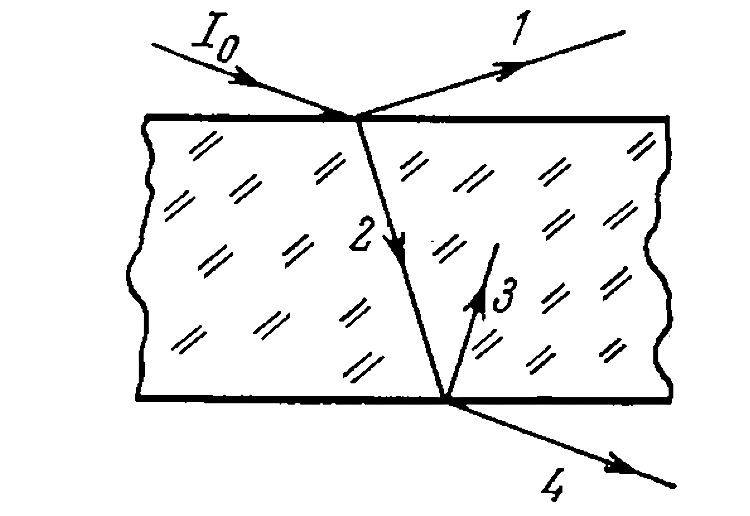A plane beam of natural light with intensity I0 falls on the surface of water at the Brewster angle. A fraction ρ=0.039 of luminous flux is reflected. Find the intensity of the refracted beam.
The enegry transmitted is, by conservation of enegry, the difference between incident energy and the reflected enegry. However the intensity is affected by the change of the cross section of the beam by refraction. Let Ai,Ar,At be the cross sections of the incident, reflected and transmitted beams. Then
Ai=Ar
At=Aicosrcosi
But at Brewster's angle r=90−i
so At=Aitani=nAi
Thus It(1−ρ)I0n

Topper's Solved these Questions
- OPTICSBOOK - IE IRODOV, LA SENA & SS KROTOVCHAPTER - OPTICSEXERCISE - Dispersion And Absorption Of Light
24 Videos
- OPTICSBOOK - IE IRODOV, LA SENA & SS KROTOVCHAPTER - OPTICSEXERCISE - Optics Of Moving Sources
22 Videos
- OPTICSBOOK - IE IRODOV, LA SENA & SS KROTOVCHAPTER - OPTICSEXERCISE - Diffraction Of Light
60 Videos
- MECHANICSBOOK - IE IRODOV, LA SENA & SS KROTOVCHAPTER - MECHANICSEXERCISE - Mechanics Problems
92 Videos
- OSCILLATIONS AND WAVESBOOK - IE IRODOV, LA SENA & SS KROTOVCHAPTER - OSCILLATIONS AND WAVESEXERCISE - Electromagnetic Waves, Radiation
36 Videos
Similar Questions
A narrow beam of natural light falls on the surface of a thick transparent plane-parallel plate at the Brewster angle. Its top surface. Find the degree of polarization of beams 1−4 (Fig.)

View SolutionA beam of plane-polarized light falls on the surface of water at the Brewster angle. The polarization plane of the electric vector of the electromagnetic wave makes an angle φ=45∘ with the incidence plane. Find the reflection coefficient.
View Solution
Knowledge Check
An unpolarised beam of intensity I0 falls on a polariod. The intensity of the emergent light is :
AI02BI0CI04DZeroA parallel beam of monochromatic light is incident on the surface of water having refractive index 4/3. The direction of the incidence beam bisects the angle between the normal to the water surface and the water surface. The angles of incidence and refraction are
Ai=30∘,r=20∘Bi=45∘,r=20∘Ci=45∘,r=32∘Di=60∘,r=40∘Unpolarized light of intensity I0 is incident on surface of a block of glass at brewster's angle. In that case, which one of the following statements is true-
Areflected light is completely polarized with intensity less than I0/2Btransmitted light is completely polarized with intensity less than I0/2CTransmitted light is partially polarized with intensty I0/2Dreflected light is partially polarized with intensity I0/2
A beam of natural light falls on the surface of glass at an angle of 45∘. Using the Fresnel equations, find the degree of polarization of
(a) reflected light,
(b) refracted light.
View SolutionUnpolarised light of intensity I0 is incident on surface of a block of glass at Brewster's angle. In that case which one of the following startements is true?
View SolutionA circular beam of light (diameter d) falls on a plane surface of a liquid. The angle of incidence is 45∘ and refractive index of the liquid is μ. The diameter of the refracted beam is
View SolutionAn unpolarized beam of light has intensity I0 . It is incident on to ideal polarizing sheets . The angle between the axes of polarization of these sheets is θ . Find θ if the emerging light has intensity I0/4)
View SolutionAn unpolarized light beam is incident on a surface at an angle of incidence equal to Brewster's angle. Then,
View Solution
